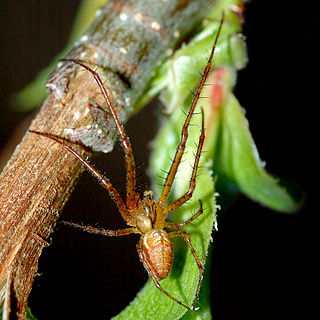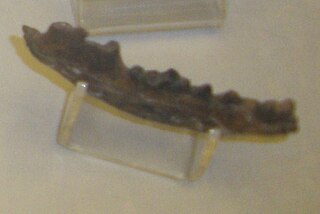
Long-jawed orb weavers or long jawed spiders (Tetragnathidae) are a family of araneomorph spiders first described by Anton Menge in 1866. They have elongated bodies, legs, and chelicerae, and build small orb webs with an open hub with few, wide-set radii and spirals with no signal line or retreat. Some species are often found in long vegetation near water.
Pachygnatha zappa is a spider named after musician Frank Zappa because of its unique markings which resemble his famous moustache.

Leucauge is a spider genus of long-jawed orb weavers, with over 160 species and fully pantropical distribution.

Pachygnatha is a genus of long-jawed orb-weavers that was first described by Carl Jakob Sundevall in 1823.

Pachygnatha degeeri is a spider in the family of long-jawed orb weavers (Tetragnathidae).
Pachygnatha clerckoides is a spider species found in Bulgaria and Macedonia.
Pachygnatha simoni is a spider species found in Spain.
Pachygnatha sundevalli is a spider species in the family Tetragnathidae, found in Portugal and Spain.
Pachygnatha terilis is a spider species found in Switzerland, Austria and Italy.
Pachygnatha tullgreni is a spider species found in Portugal.

Metleucauge is a genus of long-jawed orb-weavers that was first described by Herbert Walter Levi in 1980.

Pachygnatha clercki is a species of long-jawed orb weaver in the family of spiders known as Tetragnathidae. It is found in North America, Europe, Caucasus, Russia, Central Asia, China, Korea, and Japan.
Pachygnatha furcillata is a species of long-jawed orb weaver in the spider family Tetragnathidae. It is found in the United States.
Pachygnatha autumnalis is a species of long-jawed orb weaver in the spider family Tetragnathidae. It is found in the United States, Canada, and Cuba.
Pachygnatha tristriata is a species of long-jawed orb weaver in the family of spiders known as Tetragnathidae. It is found in the United States and Canada.
Pachygnatha brevis is a species of long-jawed orb weaver in the spider family Tetragnathidae. It is found in the United States and Canada.
Epistrophe xanthostoma is a species of syrphid fly in the family Syrphidae.
Prochyliza is a genus of waltzing flies in the family Piophilidae. There are about 11 described species in Prochyliza.

Prochyliza xanthostoma, the waltzing fly, is a species of carrion-feeding cheese skipper, insects in the family Piophilidae and the order Diptera. P. xanthostoma is a member of the genus Prochyliza, which contains eleven species. The adult flies are found through North America and are brown-bodied, with orange and black coloring. Mating occurs on animal carcasses and male perform mating rituals; females engage in ejaculate feeding. The waltzing fly is known for its exaggerated sexual dimorphism and has thus become a prominent model for sexual dimorphism and larval behavior. These organisms are known as cheese skippers because when startled, the larvae can leap several inches into the air. P. xanthostoma is an important model organism for sexual selection, larval behavior, and adult reproductive success and survivability.

Pannonictis is a genus of extinct mustelids. It is first known from the very Late Pliocene and survived until the end of the Villafranchian, and is most commonly recorded from deposits between 2.6 and 1.4 Ma. Remains of Pannonictis have been found throughout Eurasia, from the Iberian Peninsula to eastern China.







